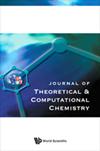Structure–Activity relationship studies of two dietary flavonoids and their Nitric Oxide Synthase inhibition activity by spectroscopic and quantum/classical computational techniques
IF 2.4
Q3 Computer Science
Journal of Theoretical & Computational Chemistry
Pub Date : 2019-11-04
DOI:10.1142/s0219633619500317
引用次数: 8
Abstract
The Nitric Oxide Synthase inhibitory activity of two dietary phytocompounds naringenin and quercetin that belong to the family of flavonoids was studied by spectroscopic and computational methods. The determining role played by the global reactivity parameters that were calculated using spectroscopic and computational methods were correlated with the Nitric Oxide Synthase inhibitory activity by a Quantitative Structure–Activity Relationship (QSAR) study. The inter and intramolecular charge–transfer interactions responsible for the biological activity of naringenin and quercetin were studied using Natural Bond Orbital Analysis. The reactive sites of the title compounds were studied using their molecular electrostatic map. The likelihood of naringenin and quercetin to be a small drug molecule was determined by Lipinski’s rule. The molecular dynamics and docking studies were carried out to test the energetic and structural favorability of the inhibition of Nitric Oxide Synthase by small drug molecules naringenin and quercetin. Experimental cell culture-based in vitro assays were done to test theoretical predictions. A QSAR study revealed that for Nitric Oxide Synthase inhibitory activity to be better, the compounds belonging to the family of flavonoids ought to have a more negative ionization energy and chemical softness while bandgap and electrophilicity index ought to be more positive.用光谱和量子/经典计算技术研究两种膳食黄酮类化合物的构效关系及其对一氧化氮合酶的抑制活性
采用光谱法和计算法研究了黄酮类化合物柚皮素和槲皮素对一氧化氮合酶的抑制作用。通过定量结构-活性关系(QSAR)研究,使用光谱和计算方法计算的全局反应性参数所起的决定作用与一氧化氮合酶抑制活性相关。利用自然键轨道分析研究了柚皮素和槲皮素生物活性的分子间和分子内电荷转移相互作用。用分子静电图谱研究了标题化合物的反应位点。柚皮素和槲皮素成为小药物分子的可能性由利平斯基规则确定。进行了分子动力学和对接研究,以测试小药物分子柚皮素和槲皮素对一氧化氮合酶的抑制作用在能量和结构上的有利性。进行了基于实验细胞培养的体外测定以测试理论预测。QSAR研究表明,为了使一氧化氮合酶的抑制活性更好,类黄酮家族的化合物应该具有更负的电离能和化学柔软度,而带隙和亲电指数应该更正。
本文章由计算机程序翻译,如有差异,请以英文原文为准。
求助全文
约1分钟内获得全文
求助全文
来源期刊
CiteScore
1.70
自引率
0.00%
发文量
0
审稿时长
3 months
期刊介绍:
The Journal of Theoretical and Computational Chemistry (JTCC) is an international interdisciplinary journal aimed at providing comprehensive coverage on the latest developments and applications of research in the ever-expanding field of theoretical and computational chemistry.
JTCC publishes regular articles and reviews on new methodology, software, web server and database developments. The applications of existing theoretical and computational methods which produce significant new insights into important problems are also welcomed. Papers reporting joint computational and experimental investigations are encouraged. The journal will not consider manuscripts reporting straightforward calculations of the properties of molecules with existing software packages without addressing a significant scientific problem.
Areas covered by the journal include molecular dynamics, computer-aided molecular design, modeling effects of mutation on stability and dynamics of macromolecules, quantum mechanics, statistical mechanics and other related topics.

 求助内容:
求助内容: 应助结果提醒方式:
应助结果提醒方式:


